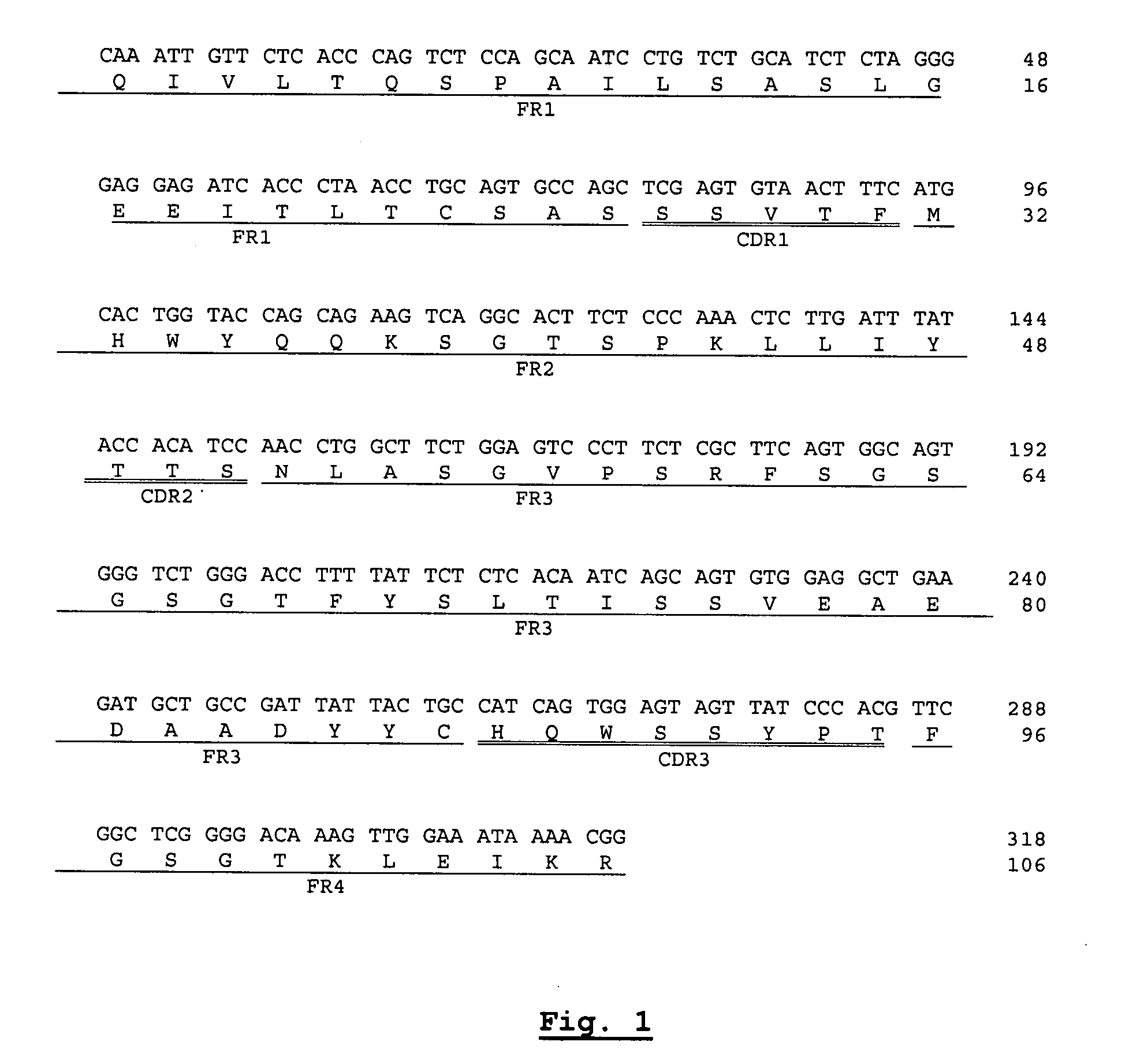Nucleotide and protein sequences of an antibody directed against an epitope common to human acidic and basic ferritins, monoclonal antibodies or antibody-like molecules comprising these sequences and uses thereof
a technology of acidic and basic ferritins and protein sequences, which is applied in the field of humanized chimeric and humanized monoclonal antibodies, fragments thereof, and antibody-like molecules, and can solve the problems of cell membrane permeation, cell death, and systemic inflammatory effects
- Summary
- Abstract
- Description
- Claims
- Application Information
AI Technical Summary
Problems solved by technology
Method used
Image
Examples
example 1
Monoclonal Anti-Ferritin Antibody AMB8LK
[0154]AMB8LK is a monocolonal IgG1 anti-ferritin antibody at 1-10 mg / ml in PBS. This antibody was obtained as previously described by Kadouche et al “Analysis of various isoferritins with monoclonal antibodies]. C R Seances Acad Sci III 1982; 295 (6):443-8, after immunization of female Balb / c mice with ferritin extracted from human spleen. Spleen cells of the best responders were fused with murine Sp2 / 0 (ATCC Number: CRL-1581) myeloma cells using polyethylene glycol 4000 according to standard protocols and selected hybridomas were cloned, expanded and cultured in vitro. AMB8LK was selected for its very high affinity of 5.1×10−9 M, and its specificity for human ferritin.
example 2
Conjugation of the DPTA and DOTA Chelates on AMB8LK
[0155]The bifunctional chelators pSCN-Bz-DTPA (2-(4-isothiocyanatobenzyl)-diethylenetriaminepentaacetic acid), pSCN-Bz-CHX-A″-DTPA ((R)-2-amino-3-(4-isothiocyanantophenyl)propyl]-trans-(S,S)-cyclohexane-1,2-diamine-pentaacetic acid) and pSCN-Bz-DOTA (2-(4-isothiocyanatobenzyl)-1,4,7,10-tetraazacyclododecane-1,4,7,10-tetraacetic acid) (FIG. 10) were purchased from Macrocyclics. These ligands were then conjugated to AMB8LK as previously described by Cooper et al., “Conjugation of chelating agents to proteins and radiolabeling with trivalent metallic isotopes.”Nature Protocols 2006; 1:314-17. Briefly, the antibody was preincubated at room temperature with EDTA, transferred to HEPES 0.1 M, pH8.5 and the concentration was adjusted to 5-10 mg / ml. Solutions of the chelators in ethanol were added drop wise to the antibody solution at 50 equivalents of chelate / antibody, unless stated otherwise. The reaction was allowed to proceed overnight a...
example 3
Size-Exclusion Chromatography
[0158]Size-exclusion high liquid performance chromatography (SE-HPLC) analysis was performed using a Beckman 114M solvent module-pump with a Beckmamn 340 injection module and a Beckman 160 absorbance detector connected to a Raytest gamma radioactivity detector. Stationary phase was a BioSep SEC-53000 column 300×7.8 mm (Phenomex, Cheshire, UK). Isocratic elution with 0.1 M phosphate buffer (0.06 M Na2HPO4, 0.04 M NaH2PO4, 2 mM EDTA, pH 7) was used at a flow rate of 0.5 ml / min. Chromatograms were analyzed using Galaxie (Novell) software.
PUM
| Property | Measurement | Unit |
|---|---|---|
| Cytotoxicity | aaaaa | aaaaa |
Abstract
Description
Claims
Application Information
 Login to View More
Login to View More - R&D
- Intellectual Property
- Life Sciences
- Materials
- Tech Scout
- Unparalleled Data Quality
- Higher Quality Content
- 60% Fewer Hallucinations
Browse by: Latest US Patents, China's latest patents, Technical Efficacy Thesaurus, Application Domain, Technology Topic, Popular Technical Reports.
© 2025 PatSnap. All rights reserved.Legal|Privacy policy|Modern Slavery Act Transparency Statement|Sitemap|About US| Contact US: help@patsnap.com



